The critically endangered`Ilioholoikauaua, the Hawaiian monk seal, continues to dwindle in numbers. Environmental groups have pushed the National Ocean0graphic and Atmospheric Administration (NOAA) to expand the critical habitat designation for the Hawaiian monk seal to include the main Hawaiian islands. NOAA recently issued its proposed revised critical habitat which thankfully includes most of the main Hawaiian islands. Although a few special interests such as the fishing lobby, have problems with this new rule, most environmental and progressive groups agree that the critical habitat should be expanded.
However, the plan is deeply flawed, but no one is talking about it. Vast areas are excluded from the proposed critical habitat because of exemptions granted to the military. See the maps below. Military activities are among the most hazardous to marine mammals. And yet, the military may get broad exemptions. See also excerpts from the proposed rule below.
Similar environmental exemptions were also given to the military in the designation of the Papahanaumokuakea National Marine Monument. It become of a model of marine conservation being used to shield military activities. Soon after the Papahanaumokuakea National Marine Monument was created, the U.S. created a similar marine monument encompassing the Mariana Islands. The UK followed suit and imposed a marine monument over the Chagos archipelago in the Indian Ocean, which effectively barred the native Chagossian people from returning to their home island of Diego Garcia, from which the islanders were forcibly removed to make way for a U.S. military base.
It seems that the new proposed critical habitat protects navy SEALS over endangered monk seals. NOAA is accepting comments on the proposed rule until August 31, 2011. Testify that the military areas should not be excluded from the proposed critical habitat for the Hawaiian monk seal.
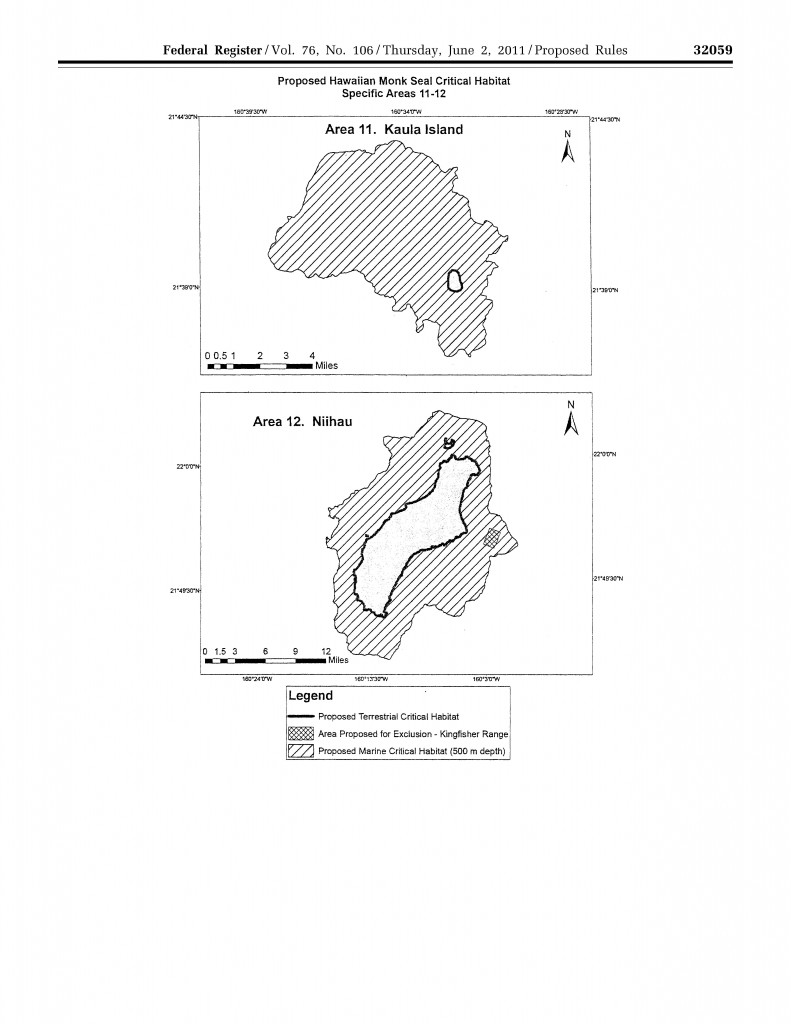
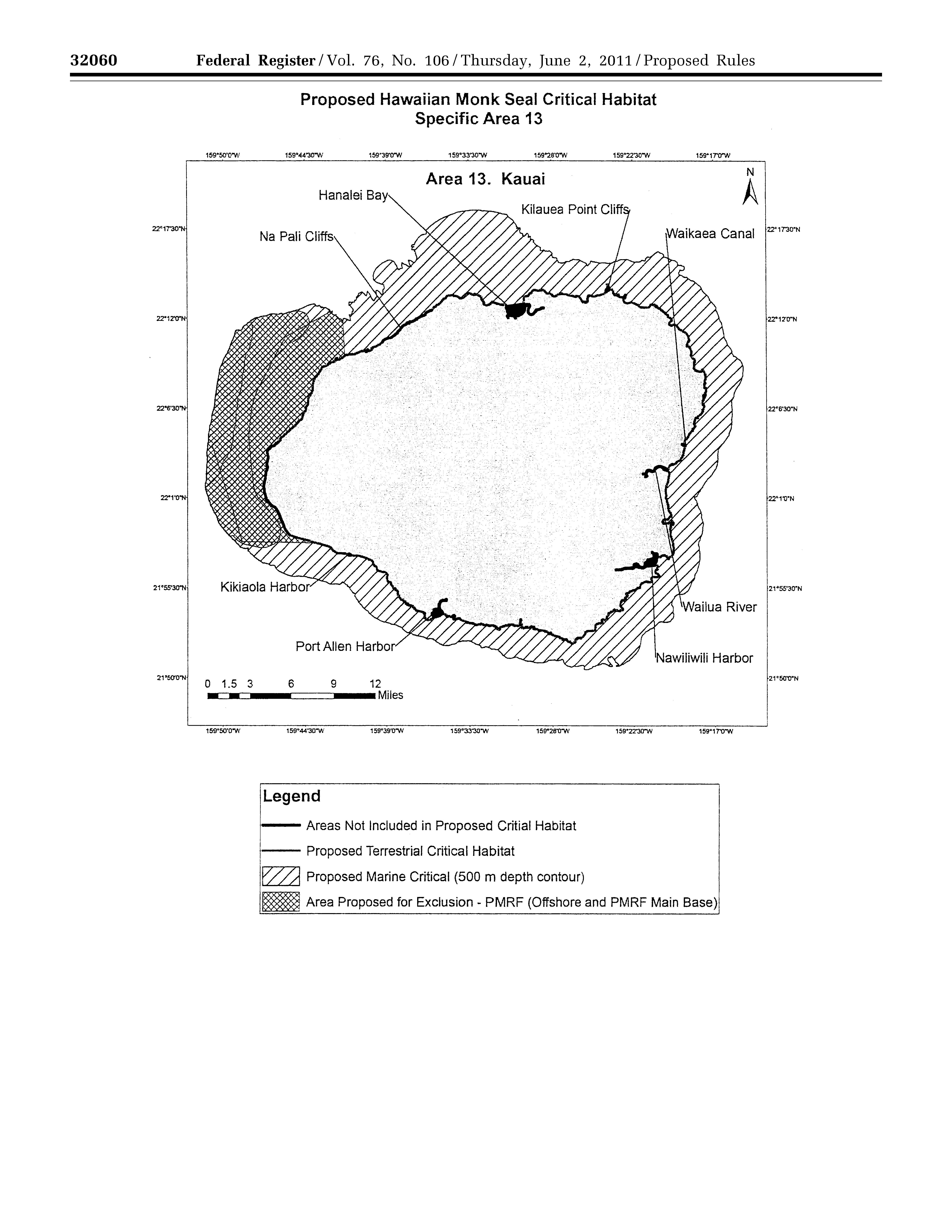
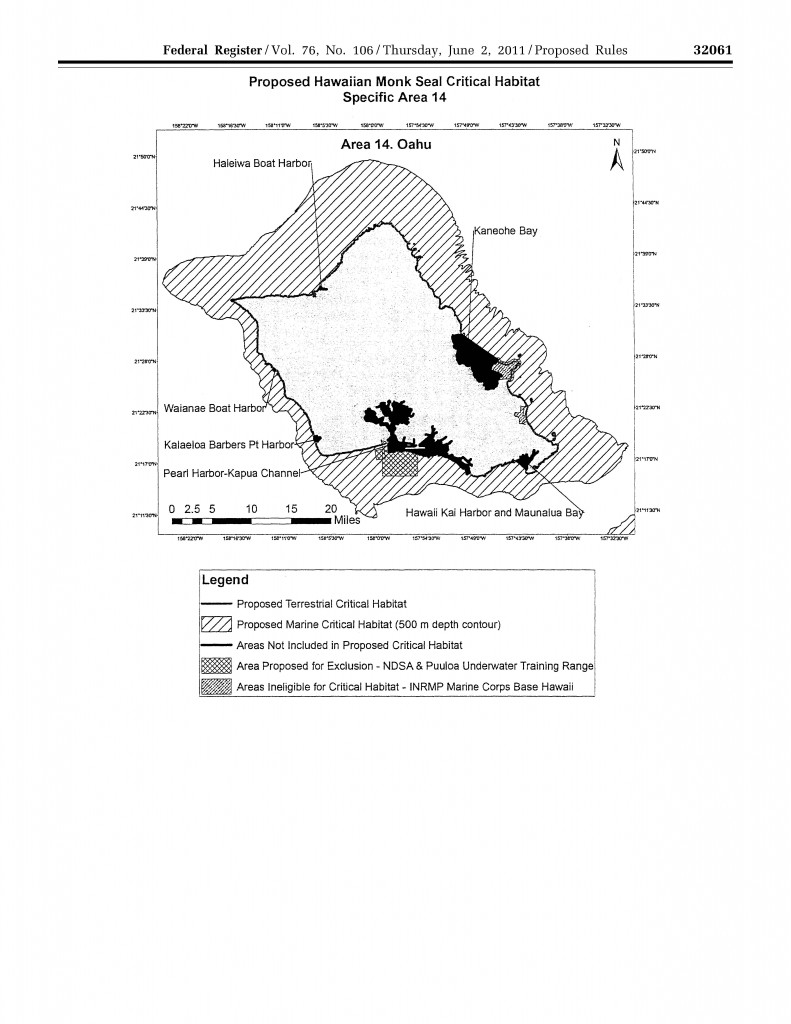
Military Areas Ineligible for Designation (4(a)(3) Determinations)
The Sikes Act of 1997 (Sikes Act, 16 U.S.C. 670a) requires military installations with ‘‘land and water suitable for the conservation and management of natural resources’’ to complete an integrated natural resource management plan (INRMP). The plans are meant to integrate implementation of the military mission of the installation with the stewardship of the natural resources found on site. Each INRMP includes: An assessment of the ecological needs on the installation, including the need to provide for the conservation of listed species; a statement of goals and priorities; a detailed description of management actions to be implemented to provide for these ecological needs; and a monitoring and adaptive management plan. Each INRMP must to the extent appropriate and applicable, provide for: Fish and wildlife management; fish and wildlife habitat enhancement or modification; wetland protection, enhancement, and restoration where necessary to support fish and wildlife or plants; and enforcement of applicable natural resource laws. INRMPs are prepared in cooperation with the USFWS and the appropriate state fish and wildlife agency, and are subject to review no less than every 5 years.
Section 4(a)(3)(B)(i) of the ESA states: ‘‘The Secretary shall not designate as critical habitat any lands or other geographical areas owned or controlled by the Department of Defense, or designated for its use, that are subject to an integrated natural resources management plan prepared under section 101 of the Sikes Act (16 U.S.C. 670a), if the Secretary determines inwriting that such plan provides a benefit to the species for which critical habitat is proposed for designation.’’
We contacted the Department of Defense (DOD) and requested information on all INRMPs for DOD facilities that overlap with the specific areas considered for designation as critical habitat and that might provide a benefit for Hawaiian monk seals. Both the U.S. Marine Corps (USMC) and the Navy provided us with INRMPs for review under 4(a)(3)(B)(i) of the ESA. The USMC provided an INRMP covering the years 2006–2011 for the Marine Corps Base Hawaii (MCBH). Areas subject to the MCBH INRMP that overlap with the areas under consideration for critical habitat include: Marine Corps Base Hawaii, Kaneohe Bay (MCBH–KB), and the 500-yard buffer zone in marine waters surrounding the Mokapu Peninsula, Oahu; Marine Corps Training Area Bellows (MCTAB) Waimanalo, Oahu; and Puuloa Training Facility, on the Ewa coastal plain, Oahu.
The Navy identified two INRMPs as relevant to this review process: The Pacific Missile Range Facility (PMRF) INRMP and the Naval Station Pearl Harbor INRMP, now referred to as the Joint Base Pearl Harbor-Hickam INRMP. The Navy has been working with cooperating partners, in accordance with the SIKES Act (Sikes Act, 16 U.S.C. 670a), to revise both documents and multiple drafts of the documents and relevant materials were presented to NMFS for review. Areas subject to the PMRF INRMP that overlap with the areas under consideration for critical habitat include: PMRF Main Base at Barking Sands, Kauai; and Kaula Island. Although the 2001 Naval Station Pearl Harbor INRMP only covers those areas in the Pearl Harbor Complex that are not included in the areas under consideration, the Navy has identified that the Joint Base Pearl Harbor-Hickam INRMP will include the following areas that overlap with the proposed designation: The Navy Defensive Sea Area (NDSA), and the marine reserved zone outside Pearl Harbor and Navy retained lands at Kalaeloa (Nimitz Beach and White Plains Beach), Oahu.
[…]
Exclusions Based on Impacts to National Security
The national security benefits of exclusion are the national security impacts that would be avoided by excluding particular areas from the designation. We contacted representatives of DOD and the Department of Homeland Security to request information on potential national security impacts that may result from the designation of particular areas as critical habitat for the Hawaiian monk seal. In response to the request, the U.S. Air Force, the U.S. Army, and the U.S. Coast Guard made no requests for exclusion from the critical habitat areas under consideration. Both the U.S. Navy and the USMC identified sites that overlap with the areas under consideration. Both requested that we exclude all identified sites of overlap that met the definition of critical habitat (i.e., areas that contain essential features that may require special management or protection) from the Hawaiian monk seal critical habitat designation. Sites identified by the USMC subject to the MCBH INRMP (MCBH–KB and the 500-yard (457.2 m) buffer zone in marine waters surrounding the Mokapu Peninsula, Oahu; MCTAB Waimanalo, Oahu; and Puuloa Training Facility, the Ewa coastal plain, Oahu) are not eligible for critical habitat in accordance with 4(a)(3) of the ESA (See Military Areas Ineligible for Designation (4(a)(3)
determinations) above).Consultation and discussion with the Navy and USMC resulted in the identification of 13 areas (See Table 2) that may warrant exclusion based on national security impacts. As in the analysis of economic impacts, we weighed the benefits of exclusion (i.e., the impacts to national security that would be avoided) against the benefits of designation. The Navy and USMC provided information regarding the activities that take place in each area, and they assessed the potential for a critical habitat designation to adversely affect their ability to conduct operations, tests, training, and other essential military activities. The possible impacts to national security summarized by both groups included restraints and constraints on military operations, training, research and development, and preparedness vital for combat operations for around the world.
TABLE 2:
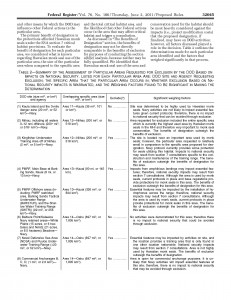
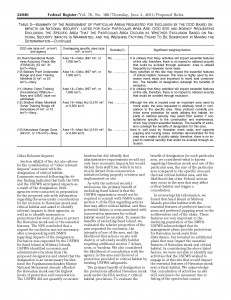
http://www.noaanews.noaa.gov/stories2011/20110608_monkseal_criticalhabitat.html
NOAA proposes critical habitat revision for the Hawaiian monk seal, seeks public comment
June 8, 2011

Hawaiian monk seal hauled out on a beach in the Northwestern Hawaiian Islands to rest.
Download here. (Credit: NOAA.)
NOAA’s Fisheries Service has proposed 16 areas as critical habitat for the endangered Hawaiian monk seal under the Endangered Species Act (ESA), and is inviting public comment. The proposed revision includes expanding the 1988 critical habitat designation in the Northwestern Hawaiian Islands, and adding new areas throughout the main Hawaiian Islands.
In July 2008, NOAA Fisheries Service received a petition from non-governmental organizations to revise the Hawaiian monk seal critical habitat designation under the ESA. In June 2009, NOAA Fisheries Service released a 12-month finding, which is one step in the review process, announcing that the petition presented substantial scientific information indicating that a revision to the current critical habitat designation was warranted and announced its intention to move forward with a proposed rule.
Following this announcement, NOAA Fisheries Service convened a Critical Habitat Review Team of experts in the field of Hawaiian monk seal biology and management to evaluate critical habitat for the species.
“Monk seals are an important species for Hawaii, and such a valuable part of our ecosystem,” said Michael Tosatto, NOAA Fisheries Pacific Islands regional administrator. “This species faces a number of threats, and it’s imperative we ensure they have safe areas where they can rest and take care of their young.”
The team identified essential features for Hawaiian monk seal habitat, such as their need for reproduction, rearing of offspring, foraging, resting and habitat protected from disturbance. The team then identified areas throughout the Hawaii that met the criteria. NOAA Fisheries Service also considered the economic, national security and other relevant effects to the proposed areas.

A group of seals resting on a beach in the Northwestern Hawaiian Islands.
Download here. (Credit: NOAA.)
Under the ESA, critical habitat is an area which may require special management or protections essential for the conservation of a listed species. Federal agencies must take precautions to insure that activities they fund, authorize or carry out do not destroy or adversely modify critical habitats.
Biologists estimate that only 1,160 Hawaiian monk seals exist, and are in danger of extinction because of their declining population in the Northwestern Hawaiian Islands.
Monk seals are wide ranging pinnipeds that require both marine and land habitats for reproduction, rearing, foraging and resting. However, unlike other well recognized pinnipeds that congregate in large numbers at rookeries, monk seals are considered a solitary species. They generally prefer to haul out in remote areas for reproduction and rest. The proposed revision to Hawaiian monk seal critical habitat allows NOAA Fisheries Service to incorporate new scientific information available regarding Hawaiian monk seals’ habitat use, and will allow for the conservation of those areas essential for Hawaiian monk seal survival and recovery.
NOAA’s Fisheries Service is accepting comments on the proposed revision through August 31, 2011. Dates, times and venues for public hearings will be available on our website at: http:www.fpir.noaa.gov. NOAA’s Fisheries Service will review comments and issue a final rule, expected by June 2, 2012.
To submit comments on the proposed critical habitat revision for the Hawaiian monk seal, use any of the following methods:
- Submit comments online via the Federal eRulemaking Portal at http://www.regulations.gov.
- Mail or hand deliver written comments to:
Regulatory Branch Chief
Protected Resources Division
NMFS Pacific Islands Region
1601 Kapiolani Blvd., Suite 1110
Honolulu, HI 96814
Attn: Proposed Critical Habitat Revision for the Hawaiian monk seal
NOAA’s mission is to understand and predict changes in the Earth’s environment, from the depths of the ocean to the surface of the sun, and to conserve and manage our coastal and marine resources. Find us on Facebook.
Just FYI, according to the Endangered Species Act, NMFS is actually not ALLOWED to include military areas if the installation’s Integrated Natural Resources Management Plan (INRMP) has “a benefit to the species.” So the military isn’t getting exemptions from monk seal critical habitat, most of their areas are actually INELIGIBLE to even be considered for designation as critical habitat – the law doesn’t allow NMFS to designate or exempt those areas. That’s what the heading “Military Areas Ineligible for Designation (4(a)(3) Determinations)” means.
Thanks for the clarification. INELIGIBLE is worse. And it goes to the heart of the problem: the military considers itself above the law. The community, as well as those in the agencies charged with protecting the environment, should be protesting these loopholes in the law.